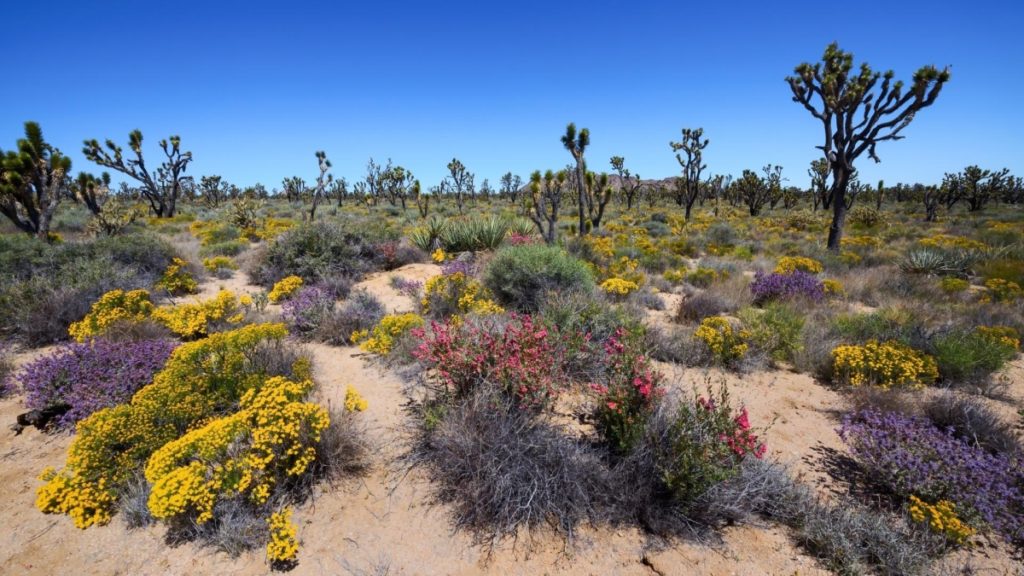
The deserts of the American Southwest include the Great Basin Desert, the Sonoran Desert, the Chihuahuan Desert and the Mojave Desert. Deserts have high daytime temperatures, wind and low precipitation.
If you live here, you may witness the transformation of a seemingly barren landscape into a multitude of colors and new life. Many wildflowers bloom throughout the year in these varied landscapes but it is in spring and summer that desert floors and mountain tops are ablaze in the numerous colors of the wildflowers.
Mountains stretching into Northern Mexico rise to over 9,000 feet in elevation. Many wildflowers found in these mountain ranges can not be found anywhere else in the United States, due unique of the unique environment. Rainfall is unpredictable, yet certain species of wildflowers manage to survive in these harsh environments.
A natural desert garden is composed of small native trees such as “Desert willow” and “Blue palo verde.” Flowering and evergreen shrubs, such as “Daleas” and “Fairydusters”, succulent cactus, agave and yucca and a myriad of small, rainy season flowers and grasses.
It is very easy to make a southwestern garden attractive to wildlife. Chuckwallas and other lizards, ground squirrels, quail, butterflies, hummingbirds moths and other wildlife abound in the desert. Add a water source and you become an oasis of sorts.
Here is a sample of some attractive native flowers and a few facts that are sure be pleasing to you and a life line for your wildlife.
Stachys coccinea (Scarlet Hedgenettle)
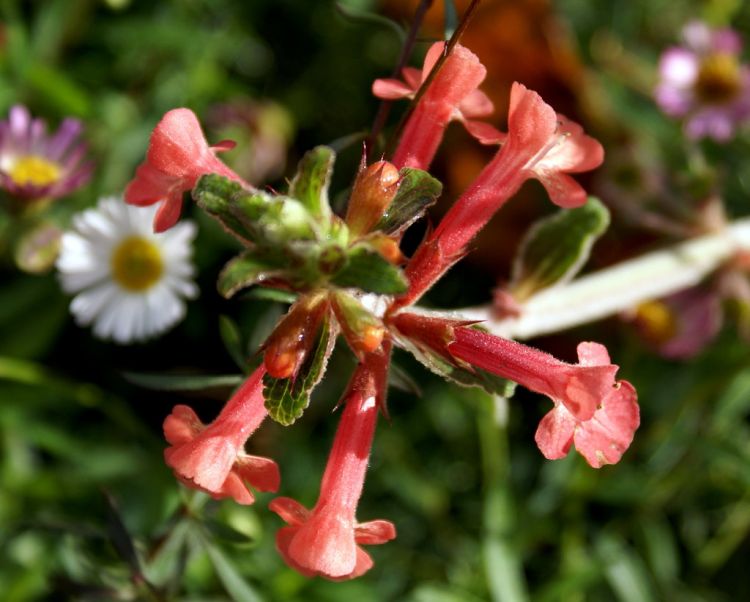
A heat loving beauty for your sunny beds, this plant needs only average garden soil and regular watering to thrive. Be sure to mulch in zone 5.
- Growing Zones: 6 – 9
- Color: Red
- Regions: Hot Deserts, USA
- Bloom Time: Summer
- Sun: Full sun and full sun with afternoon shade
- This plant is attractive to bees, butterflies and hummingbirds.
- Average Water Needs; Water regularly; do not over water.
- The stout, square stems of scarlet hedge-nettle or Texas betony rise to 3 ft. or more and are lined with pair of dark-green leaves becoming smaller up the stem.
- An erect, leafy plant, covered with soft hairs, with scarlet bilaterally symmetrical flowers in whorls at intervals in a spike at top of 4-sided stem.
- Its scarlet color distinguishes this species from other western plants of its genus which are pink or purplish.
- If cultivated, it should be grown from seed. Stachys plants have no stinging hairs, as do true nettles, but resembles nettles in other ways, especially before flowering.
Penstemon pseudospectabilis (Desert Beardtongue)
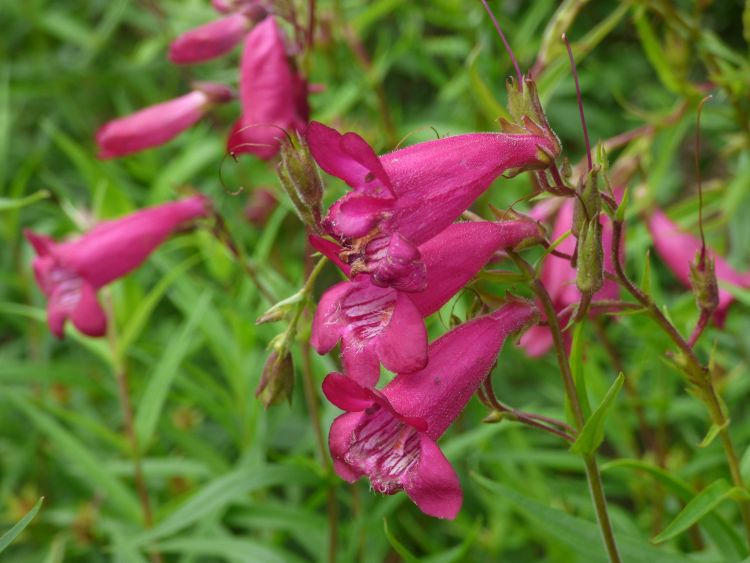
A beautiful, nearly ever-blooming species native to southern New Mexico and beyond. The long spikes of hot pink flowers contrast beautifully with the large gray leaves. Remove faded flowers and give it a few deep soakings in the heat of the summer to keep the plant blooming for many months.
- Growing zone: 5 – 10
- Color: Pink
- Bloom time: Late spring, summer
- Regions: Hot Desert, Western only
- Sun: Full sun and Afternoon sun
- Soil: Average and sandy garden soil
- Water: Xeric, water well once or twice a month. More with care.
- Height: 12in. to 36 in.
- Foliage: Evergreen
- Native Habitat: Between 2,500 feet and 4,500 feet in southwest
- Attractive to hummingbirds, butterflies and bees. Songbirds eat seeds.
- This Penstemon loves hot weather, and is recommended for use throughout the southwestern U.S.
- Penstemons abound in the southwest, here is another native for you to choose from.
Penstemon palmeri (Ballon flower)
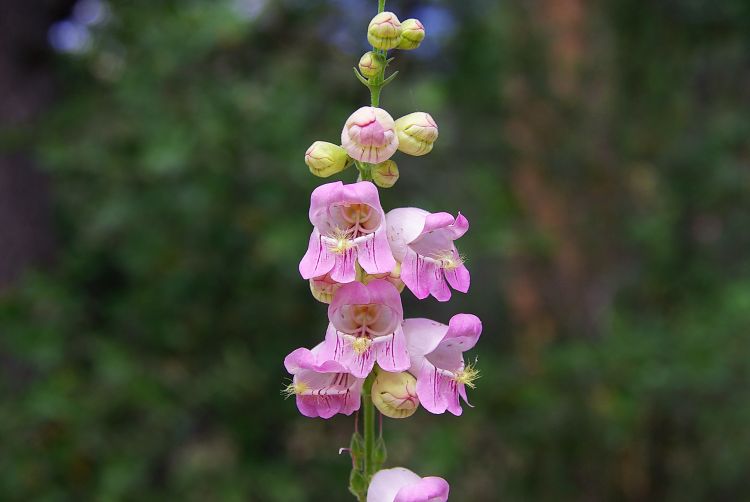
Balloon flower is a 2′ perennial with a 3′ flower spikes of 1-2″ whitish-pink flowers, over white-grey flowers. Native to desert mountains. It is fairly easy with good drainage.
- It loves it in the desert and grows into this big showy plant that is covered with 3′ spikes of large fuzzy flowers that bumblebees like to crawl into. They are excellent pollinators.
- These flowers also attract hummingbirds and seeds offer food for song birds.
- Hardy in zones 6 – 10
- Other Penstemons to consider for your southwest gardens might be Penstemon centranthifolius (Scarlet Bugler), Penstemon grinnellii (Southern woodland penstemon), and Penstemon incertus (Western desert penstemon)
Melampodium leucanthum (Blackfoot daisy)
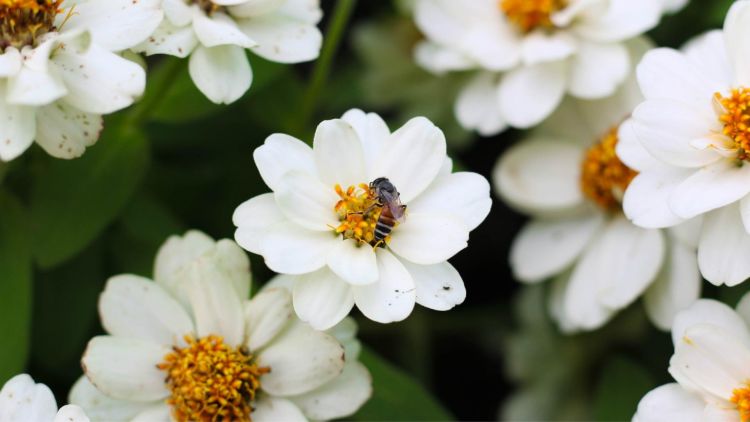
At first glance, Blackfoot Daisy appears to be the twin of White Zinnia (Zinnia acerosa), but flower heads of the latter species have 4-6 broad white rays and a narrow base of several overlapping scales. Both may be found in the same habitat, but the range of White Zinnia does not extend as far south as Blackfoot Daisy.
- Alternate name: Plains Blackfoot, Rock Daisy
- Family: Asteraceae
- Description: A low, round, bushy plant with flower heads of 8-10 broad white rays surrounding a small yellow central disk.
- Flowers: Head about 1″ (2.5 cm) wide; broad outer bracts 5, joined along one-half to two-thirds their length.
- Leaves: 3/4-2″ (2-5 cm) long, opposite, narrow.
- Fruit: Seed-like, with several narrow scales at tip.
- Height: 6-20″ (15-50 cm).
- Flower: March-November.
- Habitat: Rocky soil in deserts and on dry plains.
- Range: Kansas southwest to Arizona and Mexico.
- Hardiness Zone: 7-11
- Sun Exposure: Full sun
- Origin: Western USA from 2000 to 5000 feet (600 m to 1500 m)
- Watering Needs: Moderate water, little water in winter, needs good drainage Water established plants once a week in summer.
- Short lived perennial, slowly form a mound 1.5 feet tall (45 cm), 2 feet wide (60 cm).
- Attracts Butterflies and bees. Seeds attract song birds and small mammals.
Desert Sand Verbena (Abronia villosa)
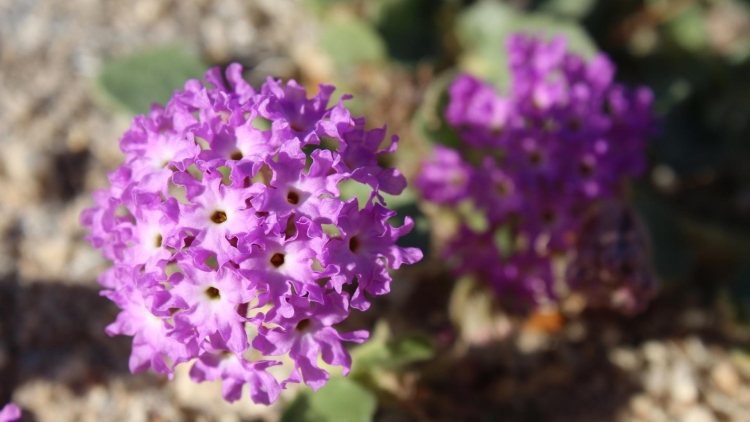
Southeastern California, southern Nevada, and western Arizona; south into northwestern Mexico. Following ample winter rains, Desert Sand Verbena may carpet miles of desert with pink.
- Family: Nyctaginaceae, Four-o’clock
- Description: A soft-haired, sticky plant with bright pink, trumpet-shaped flowers in heads that bloom on stalks growing from leaf axils.
- Flowers: head 2-3″ (5-7.5 cm) wide, with 5 lobes on end of “trumpet.”
- Leaves: 1/2-1 1/2″ (1.3-3.8 cm) long, opposite, ovate, with slightly wavy, scalloped edges.
- Fruit: with 3-5 wings.
- Creeper, with stalks to about 10″ (25 cm) high, but stems trailing on the sand, up to 3′ (90 cm) long.
- Flower: March-October.
- Habitat: Sandy desert soil.
- Zone hardy: 8 – 10.
- It is in flower from July to September.
- The plant prefers light (sandy) soils and requires well-drained soil. The plant prefers acid, neutral and basic (alkaline) soils.
- It cannot grow in the shade. It requires dry or moist soil. The plant can tolerate maritime exposure.
- Cultivation: Prefers a light well-drained sandy soil in full sun
- Propagation: Seed
Fishhook barrel cactus (Ferocactus wislizenii)
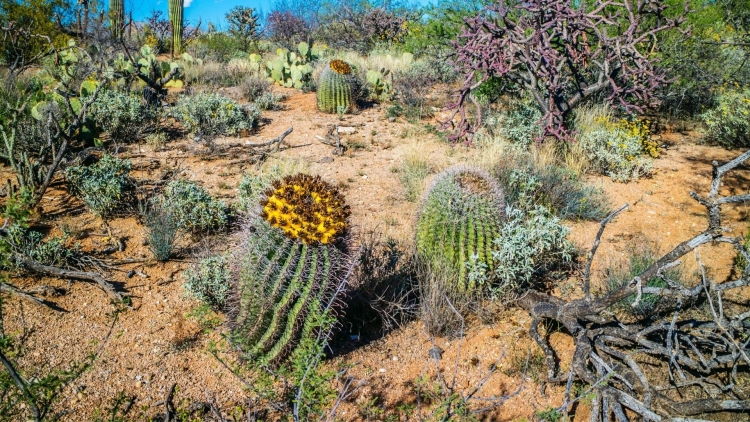
Part of the Cactaceae Family, ranging from Arizona, Texas and northern Mexico.
- Form: cylindrical cactus
- Seasonality: evergreen
- Size: 2-5ft tall, 8-24in in diameter; rare specimens to 10ft high
- Leaves: reddish spines, 2.5in long, from aeroles along ribbed portion of cylinder; stout flat thorn is curved inward; usually 3-4 spines per aerole; spines will be thinner when grown in shade
- Flowers: fiery orange blossoms; 2.5in long; in circle around top of plant (around meristem) Fruit: yellow pineapple-shaped fleshy fruit; to 2in long; persistent; favorite food of wildlife
- Stems/Trunks: usually a single column; rare specimens may be multiple
- Hardiness: to mid teens
- LANDSCAPE VALUE: specimen plant, good in containers, outstanding flower color, attractive food source for wildlife
- Exposure: full sun; okay in part shade
- Water: natural rainfall
- Soil: tolerant; good drainage
- Propagation: seed, easy; large salvaged specimens are readily available
- Maintenance: low; cleanup of trash blown in around base
Salvia greggii (Autumn sage)
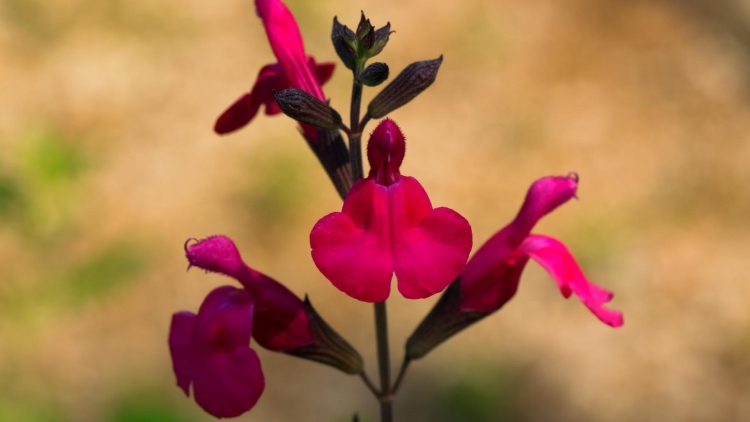
You will like this plant! In recent years many new cultivars of Autumn sage have been introduced with showy colors, including purple and cherry red. One recent selection is Salvia ‘Sierra San Antonio’. It has yellow and red bicolored blooms.
- Description: Autumn sage forms a nice mounding shrub up to 4 ft (1.2 m) tall by 2 ft (0.6 m) wide.
- Most of the branches originate near the base of the plant, giving a vase-shaped appearance.
- Many colors are available although shades of red, pink and white are the most common.
- The leaves are leathery and small, adaptations that probably help prevent moisture loss in its dry native climate. Autumn sage is usually evergreen, but a hard freeze may cause it to die to the ground, usually to reemerge in spring.
- Location: Autumn sage occurs in southwest Texas through the Chihuahuan desert into Mexico.
- Culture: Too much fertilizer and moisture will kill autumn sage. Do not plant where regular lawn fertilizations and irrigation will bother it.
- Light: Full sun to part shade; can take extreme sun and heat.
- Moisture: Autumn sage is very drought tolerant. It can take prolonged dry periods once established. Autumn sage requires well-drained soil.
- Hardiness: Zones 7 – 9 (zones 6 and possibly 5 with mulch).
- Propagation: Cuttings; may self-seed in mild climates.
- Usage: Autumn sage is good as an evergreen medium size shrub. It can be used as a xeriscape plant in hot, dry areas. Great for hummingbird and butterfly gardens as well as mixed perennial beds with plants of similar cultural requirements.
- Features: Autumn sage is a very useful landscape plant and is especially well adapted to hot, desert-like areas. It has a long period of bloom. This Salvia also provides winter interest, due to its evergreen habit. Regular pruning is suggested, since these plants can get woody and spindly.
- Attracts hummingbirds and butterflies.
- Desert bloomers are plentiful and the colors are many and bright
California poppy (Eschscholzia californica)
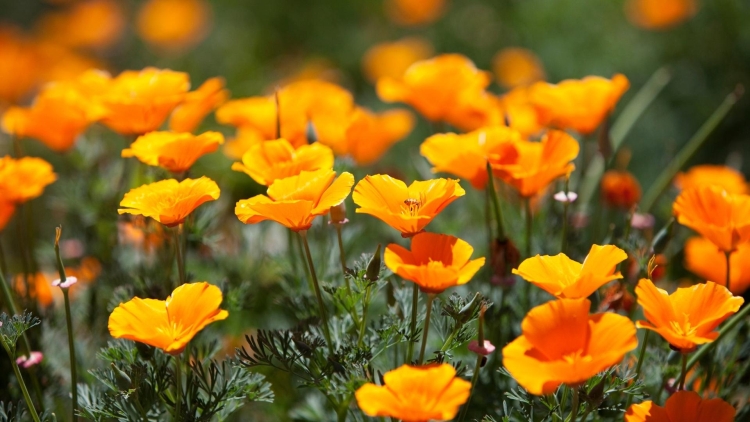
A native to grassy and open areas from sea level to 2000m (6500 feet) altitude.
- Bright orange flowers hardy to zone 6
- The leaves are leathery and small, adaptations that probably help prevent moisture loss in its dry native climate.
- Autumn sage is usually evergreen, but a hard freeze may cause it to die to the ground, usually to reemerge in spring.
- Location: Autumn sage occurs in southwest Texas through the Chihuahuan desert into Mexico.
- Culture: Too much fertilizer and moisture will kill autumn sage. Do not plant where regular lawn fertilizations and irrigation will bother it.
- Light: Full sun to part shade; can take extreme sun and heat.
- Moisture: Autumn sage is very drought tolerant. It can take prolonged dry periods once established. Autumn sage requires well-drained soil.
- Hardiness: Zones 7 – 9. (6 and possible 5 with heavy mulch)
- Propagation: Cuttings; may self-seed in mild climates.
- Usage: Autumn sage is good as an evergreen medium size shrub. It can be used as a xeriscape plant in hot, dry areas. Great for hummingbird and butterfly gardens as well as mixed perennial beds with plants of similar cultural requirements.
- Features: Autumn sage is a very useful landscape plant and is especially well adapted to hot, desert-like areas. It has a long period of bloom. This Salvia also provides winter interest, due to its evergreen habit.
- Regular pruning is suggested, since these plants can get woody and spindly.
- Desert flowers are many and the colors expand the rainbow.
Desert mallow (Sphaeralcea ambigua)
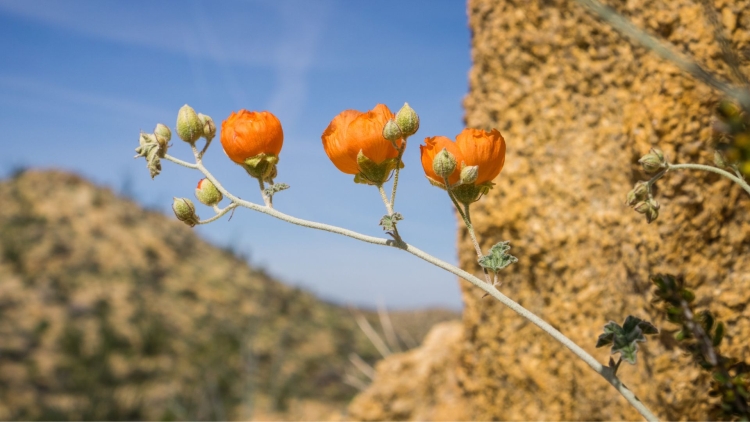
Mojave and Sonoran deserts of Southern California and Nevada, to southwest Utah through Arizona to northern Mexico.
- Zones: 6-10
- Habitat: Sandy washes and rocky hillsides, sometimes among pinyon and juniper, below 4000 feet.
Delphinium parishii (desert larkspur)
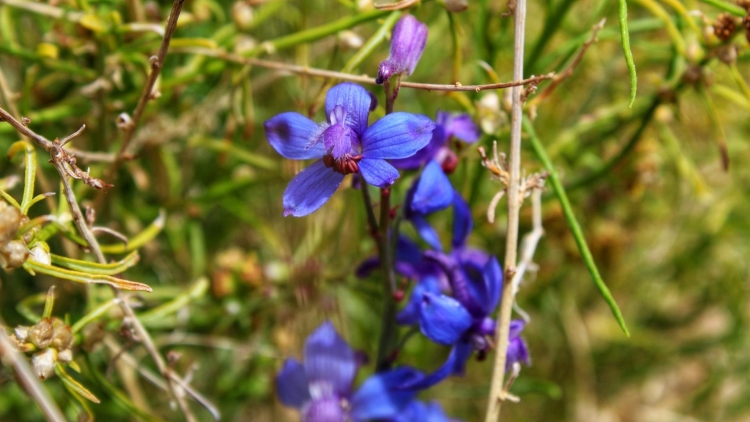
Buttercup family native to the Mojave Desert in the southwestern United States and northwest Mexico, where it is found between 900–8,000 feet altitude in California, Arizona, southwestern Utah, and Baja California.
- Zones: 8 – 10
- It is a perennial herbaceous plant growing up to 24 inches tall, with palmately lobed leaves.
- The blooms vary across the species’ range, from dark blue to purplish near Joshua Tree National Park, sky-blue in the eastern and northern parts of the desert, and pink in some areas in California.
- Bloom time occurs between April and June. It is also found in the Tehachapi Mountains.
- Yucca, Penstemons, Lewisia, Potentilla, Talinum, Prairie violet, Agave and many, many more plants of the Desert southwest can adorn your gardens and wildlife habitats.
Is it any wonder that the deserts are truly alive? Be sure to look at other regions for native plants, that includes shrubs and trees. Always offer water and additional feed if you really want to attract more wildlife.
